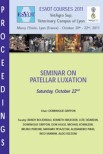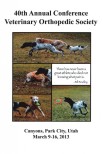Objective: To report midterm to long-term outcomes of dogs with cranial cruciate ligament (CCL) rupture and excessive tibial plateau angles (TPA) treated with a modified cranial closing wedge osteotomy (m-CCWO).
Study design: Retrospective case series.
Study population: Dogs (n = 21) with CCL rupture and excessive TPA treated with m-CCWO (n = 28).
Methods: Medical records, midterm and long-term follow-up radiographic examination records, Canine Orthopedic Index data, and owner surveys were reviewed to determine functional outcomes, owner satisfaction, and complications associated with the technique.
Results: Tibial plateau angle decreased from 42.3° ± 4.8° preoperatively to 4.8° ± 3.3° after m-CCWO. No catastrophic complications occurred, while major and minor complications occurred in three of 28 and six of 28 stifles, respectively. Canine Orthopedic Index scores and owner surveys were available in 16 of 21 dogs at a median of 608 days postoperatively (range 279-1225). Functional midterm or long-term outcomes for these dogs treated with m-CCWO were excellent in eight dogs, acceptable in seven dogs, and unacceptable in one dog. Progression of osteoarthritis was noted on all midterm and long-term follow-up radiographs. All owners but one were satisfied.
Conclusion: Modified cranial closing wedge osteotomy was associated with an acceptable morbidity and resulted in satisfactory functional outcomes in most dogs of this series.
Clinical significance: Modified cranial closing wedge osteotomy should be considered as an alternative to treat CCL rupture in dogs with excessive TPA.









